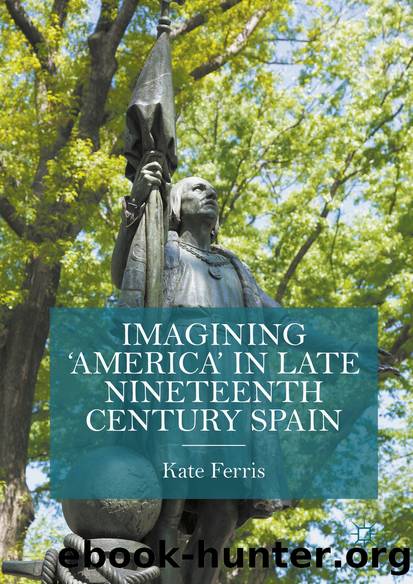Imagining 'America' in late Nineteenth Century Spain by Kate Ferris

Author:Kate Ferris
Language: eng
Format: epub
Publisher: Palgrave Macmillan UK, London
Spanish women, by contrast, had (theoretical) access to just two years of elementary education, could not work as judges, civil servants, sit on juries, testify legal documents or vote, and had limited rights to buy and transfer goods, deposit money and conduct business, which deferred entirely to their husbands upon marriage. Married Spanish women were required by the civil code to obey their husbands, who were their wivesâ legal representatives and administered any communal goods; wives had scant legal recourse in cases of adultery or in relation to her children (including extra-marital). Divorce was rejected as a âProtestant heresyâ.21
If the âdiscovery of womenâ was the âdiscovery of the centuryâ, or at least of the United Statesâ century, it follows that American women and the images of them that were projected and produced elsewhere would be taken as ciphers of both the USA and of modernity.22 American women were viewed as emblems (and repositories) of their countryâs present and other nationsâ futures. The reactions of Spaniards to the seeming liberties of American women varied considerably. Still, the Spanish images formed of American women more often than not fit within two reductive stereotypes: matrons and misses. The first image, the âmatronâ, prioritised education, industriousness, material means, morality and strength of character. The second image, the âmissâ,23 focussed on beauty, coquettishness, materialism and carefree relations between the sexes. Both images contained emancipation and independence at their core: independence of thought, of means and of movement (the apparent possibilities of US women to move around freely, without compromise to their âhonourâ, were frequently noted by Spanish observers). Of course, both images, already highly reductive, were circumscribed by race and class. Spanish images of black American and of working class, often immigrant, women were of course produced, but with far less frequency and these were not taken to stand as ciphers of national identity or experience.
Conservative Spanish businessmen, whose work took them to the United States, reported back with bemusement, affection and often distaste the flirtatious character of US women and the sharp differences they perceived between them and their Spanish counterparts. Krausist educationalists and intellectuals looked with some approval to the model provided by the East Coast womenâs colleges and female emancipatory movements and tried to reconcile their admiration for the educational provisions in the USA with an insistence that Spain would need to change its attitude towards womenâs public roles at its own pace, acknowledging that reform was still a long way off. The pioneers of Spanish feminism viewed the United States as a kind of crucible of modern womanhood in practice from which they could retrieve an âarsenal of factsâ to bolster their claims for female equivalence and greater participation for women in public life.
This chapter examines the image of North American women from diverse perspectives: from the viewpoints of Krausists such as Rafael de Labra, Fernando de Castro and the Giner de los RÃos brothers; the pioneering feminists of the late nineteenth century Concepción Arenal and Emila Pardo Bazán; and of
Download
This site does not store any files on its server. We only index and link to content provided by other sites. Please contact the content providers to delete copyright contents if any and email us, we'll remove relevant links or contents immediately.
| Africa | Americas |
| Arctic & Antarctica | Asia |
| Australia & Oceania | Europe |
| Middle East | Russia |
| United States | World |
| Ancient Civilizations | Military |
| Historical Study & Educational Resources |
Magic and Divination in Early Islam by Emilie Savage-Smith;(1501)
Ambition and Desire: The Dangerous Life of Josephine Bonaparte by Kate Williams(1346)
Bohemians, Bootleggers, Flappers, and Swells: The Best of Early Vanity Fair by Bohemians Bootleggers Flappers & Swells- The Best of Early Vanity Fair (epub)(1344)
Papillon by Henry Charrière(1311)
Twelve Caesars by Mary Beard(1258)
Operation Vengeance: The Astonishing Aerial Ambush That Changed World War II by Dan Hampton(1138)
What Really Happened: The Death of Hitler by Robert J. Hutchinson(1131)
London in the Twentieth Century by Jerry White(1114)
Time of the Magicians by Wolfram Eilenberger(1089)
The Japanese by Christopher Harding(1086)
Twilight of the Gods by Ian W. Toll(1085)
Lenin: A Biography by Robert Service(1046)
The Devil You Know by Charles M. Blow(987)
A Social History of the Media by Peter Burke & Peter Burke(940)
Freemasons for Dummies by Hodapp Christopher;(923)
Napolean Hill Collection by Napoleon Hill(905)
Henry III by David Carpenter;(892)
The Churchill Complex by Ian Buruma(884)
The Rise and Triumph of the Modern Self by Unknown(880)
